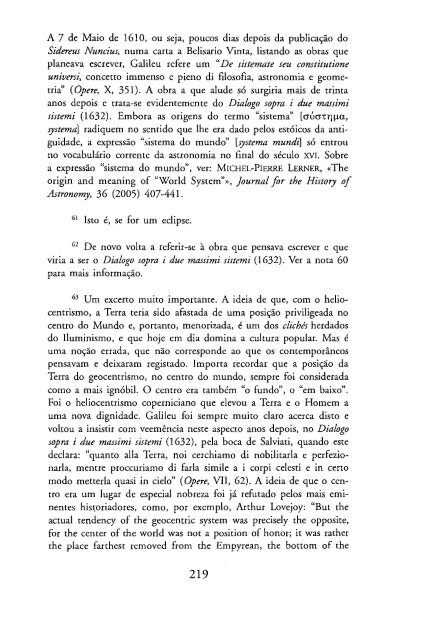O Mensageiro das Estrelas - Galileu Galilei - 1610
Livro escrito pelo cientista Galileu Galilei em 1610 sob título original de "Sidereus Nuncius". Livro científico
Livro escrito pelo cientista Galileu Galilei em 1610 sob título original de "Sidereus Nuncius". Livro científico
You also want an ePaper? Increase the reach of your titles
YUMPU automatically turns print PDFs into web optimized ePapers that Google loves.
creation, to which the dregs and baser e1ements sank. The actual centre<br />
indeed was hell", ARTHUR O LOVEJOY, The Great Chain 01 Being<br />
(New York: Harper and Row, 1960), pp. 101-102. A opinião de que<br />
o centro é o pior lugar do mundo aparece claramente em Aristóteles<br />
(De caelo, liv. II, cap. 3, 293 a) e em Cícero (De natura deorum, liv.<br />
II, cap. 6, 17), por exemplo. Em 1640, John Wilkins defendia que o<br />
principal argumento contra o copernicianismo a ser refutado era<br />
aquele "fram the Víleness of our Earth, because it consists of a more<br />
sordid and base Matter than any other part of the World; and therefore<br />
must be situated in the Center, which is the worst place, and at<br />
the greatest distance from those Purer incorruptible Bodies, the Heavens",<br />
«A Discourse concerning a new planet, tending to prove, that<br />
('tis probable) our Earth is one of the Planets», in JOHN WILKINS,<br />
Mathematical and Philosophical W0rks (London: John Nicholson,<br />
1708), p. 200. Sobre este assunto, vide REMI BRAGUE, «Le géocentrisme<br />
comme humiliation de l'homme», in R. BRAGUE et J. F.<br />
COURTiNE (eds.), Herméneutique et ontologie. Hommage à P. Aubenque<br />
(Paris, 1990), pp. 203-223, depois como: REMI BRAGUE, «Geocentrism<br />
as a humiliation for man», Medieval Encounters, 3 (I997) 187-<br />
210; DENNIS R. DANIELSON, «The great copernican cliché», American<br />
Journal 01 Physics, 69 (2001) 1029-1035; DENNIS R. DANIELSON,<br />
«The bones of Copernicus», American Scientist, 97 (2009) 50-57;<br />
DENNIS R. DANIELSON, «Myth 6: That copernicanism demoted<br />
humans fram the center of the cosmos», in: RONALD L. NUMBERS<br />
(ed.), Galileo goes to jail and other myths about science and religion<br />
(Cambridge, Mass. and London: Harvard University Press, 2009),<br />
pp. 50-58.<br />
64 Rationibus sexcentibus. <strong>Galileu</strong> escreve, literalmente,<br />
centos argumentos", com o sentido de muitos ou inumeráveis.<br />
" . selS-<br />
65 Primae ... magnitudinis. O termo moderno ("magnitude")<br />
refere uma quantidade adimensional e supõe já uma compreensão do<br />
fenómeno do brilho estelar que <strong>Galileu</strong> não tinha, e por isso traduzimos<br />
sempre por "grandezà'. Tal como os antigos, <strong>Galileu</strong> associava o<br />
brilho <strong>das</strong> estrelas à sua grandeza física real: as estrelas mais brilhantes<br />
eram, por conseguinte, maiores. A escala de grandeza estelar teve<br />
a sua origem pelo século segundo a. c., quando Hiparco classificou<br />
as estrelas visíveis a olho nu em seis grupos. As mais brilhantes foram<br />
220


